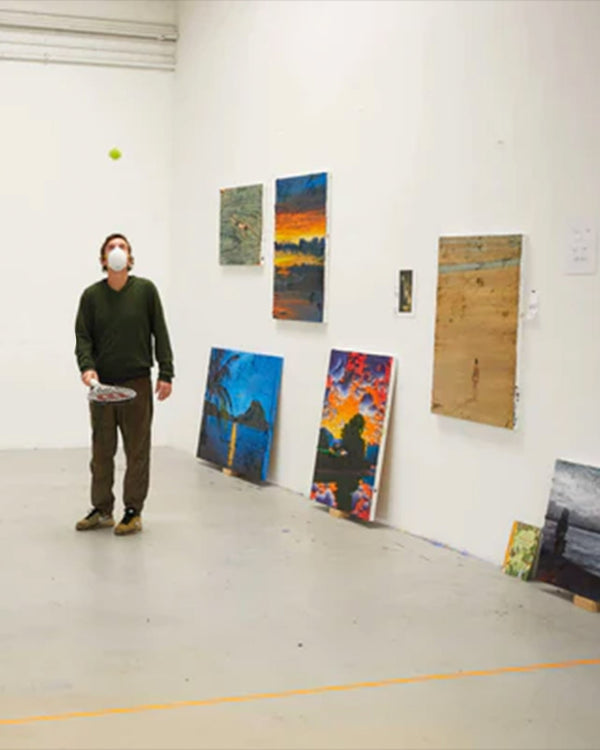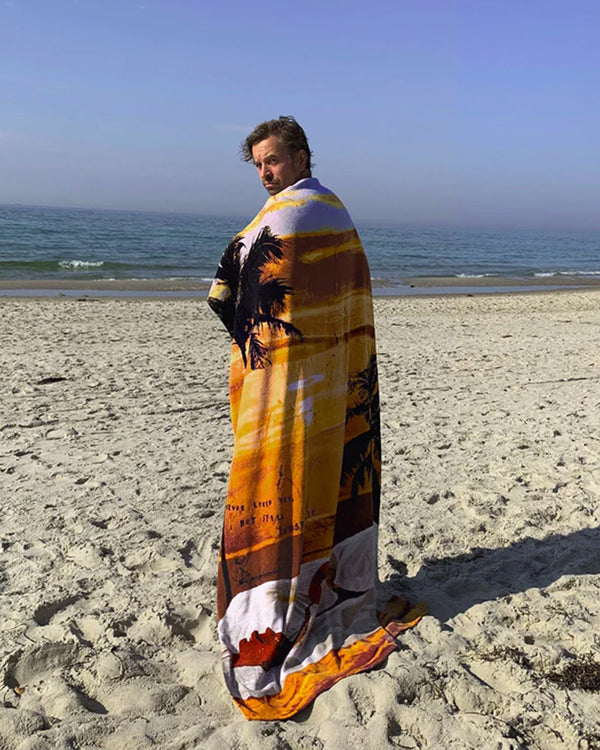FRIEDRICH
KUNATH
Trouble
in
Paradise
by Timon Karl Kaleyta
Within California’s famous beauty and grace,
there has always been a peculiar melancholy.
Within California’s famous beauty and grace, there has always been a peculiar melancholy.

© Image Michael Schmelling
Within California’s famous beauty and grace, there has always been a peculiar melancholy. It could be said that it has always been boldly opposed to the general good mood of this place – its necessary opposite, so to speak, because pristine happiness is inconceivable and certainly undesirable.
This resonant tristesse, inherent in places of longing, was reliably expressed in the arts that originated there: in novels like Bret Easton Ellis’ Below Zero; in films like David Lynch’s Mulholland Drive or Billy Wilder’s Sunset Boulevard, and of course in music as well, if one recalls only the work of Lana Del Rey, which has to be understood as a single sequence of Californian mania and depression.
So paradise is inconceivable without its opposite, without the chaos or misfortune. And it seems as though that darker side sometimes emerges a little bit more strongly, especially in places where reality feels close to how we imagined paradise. In Los Angeles, you only have to move a little off the beaten path to see it: to the outskirts beyond Malibu and Venice Beach, beyond the Hollywood Hills or beyond the famous Pacific Palisades district, that fascinating and miraculous place on the Pacific Ocean that Thomas Mann had identified in 1942 as the ideal exile from Nazi terror – this, too, is a very special story of grace and tragedy in its own right.
And precisely now, when a global pandemic is putting the world in a stranglehold and locking the doors to an otherwise public life, when people are cast back upon themselves and left to their own survival, all of a sudden this melancholy no longer seems just metaphorically enriching. Now it is real, you can marvel at it everywhere in everyday life. You learn about it in concrete terms these days if you talk to Friedrich Kunath, born in Karl-Marx-Stadt, who has been based in Los Angeles since moving there from Germany in 2007. He talks about how unvarnished and gloomy the cityscape seems to him in the current crisis, especially in areas that already seem rather un-Californian.
For example, in the concrete clad neighborhoods of East L.A. where he has his studio – an area that looks more like Detroit than Baywatch anyway – Kunath claims the makeup has now been completely removed.
© Image Michael Schmelling
However, there was always a certain melancholy present in his work – in his sculptures, his videos and installations, and most impressively in his paintings, which speak so much about happiness and sadness, yet with a light and liberating effect. If landscapes regularly appear in his work, it is not uncommon for them to look as if they reflect the low light of California. Setting suns and light-drenched cloud formations that look like nascent galaxies can been seen in Kunath’s work, as self-confident and natural as if no one in the world had ever criticized painted sunsets. Then, appearing repeatedly in between, almost lost in the picture: individuals bent over from the burden of life and themselves, sometimes in the form of ghosts, sometimes animals.
The paintings are collage-like surfaces arranged in relation to each other, and Kunath often works with projections thrown onto canvases from the outset, because he cannot stand empty canvases. This results in paintings and formations layered on top of each other. Graphics, airbrushes, and comic strips intersect and overlap alongside oil and acrylic paint. And then there is usually a linguistic level—carefully placed sentences and quotations, sometimes invented, sometimes picked up in films, songs, and books. They do not provide explanations, but rather expand the possibilities for creating meaning, sentences such as “LATELY I’VE LET THINGS SLIDE” or “AFTER THE LOVE IS GONE,” which also often function as the titles of the works.
© Image Michael Schmelling
If one only looks at the prominent color gradients, they see in Kunath’s pictures an inevitable reappearance of the legacy of German Romanticism, highly transfigured until today – natural landscapes, the gloominess of the forest, swamps, waters, meadows – but in Kunath’s work, all of this is mixed with Californian lightness and American pop culture, with the world of Mickey Mouse and Charlie Chaplin, with the ease of Caspar David Friedrich and his contemporaries finally sitting behind the wheel of an open Corvette, dashing back into the city from the beach in Malibu to the music of George Harrison.
We see sunsets, rainbows, nature, flowers, plants, the golden light of dusk: landscapes from the collective memory of the good life. These are colors and subjects that, as he himself says, are stamped out of every artist in Germany right at the beginning of their academic training, because suspicion is so obvious and so readily expressed: kitsch! With Kunath, however, everything is allowed, virtuously combined. Lonely characters that recall Edward Hopper appear, driven by wanderlust and homesickness while at the same time being exuberantly happy and in a tropical depression. Everything is a little bit like in the movies, just before the final credits roll, or maybe like in the music that is so crucial to Kunath, as though Rufus Wainwright’s Trouble in Paradise is playing on repeat in the background.

© Image Michael Schmelling
Overall, his works don’t follow a particular formal approach, but rather an emotional one. In some ways, they speak of melancholy and nostalgia, the experience of looking back at oneself, as is particularly evident in his installation All Your Fears Trapped Inside (2019). Kunath created a room in the true sense of the word: a teenager’s room (perhaps his own?) filled with furniture, objects, and memories – exquisitely arranged, as though to form a mini-retrospective of oneself – with a life-like bronze statue as the viewer outside of the room, looking in at this life with interest from the outside.
Kunath’s nostalgia, however, is always a nostalgia that is bent around the obvious, one that is already relativized. It is clear that if one simply gives in to it, they will immediately fall into the trap of nostalgia, of this seductive feeling. It is not better to just let it go, however, but to make it productive, to relate to it. He says, “In the end, nostalgia means memory without the pain, and once you’ve realized that, there’s an amazing technique for dealing with it: irony.” Correspondingly, playful irony is Kunath’s tool, and long before it becomes too dramatic, his work veers off reliably into the grotesque, the surprising, and the ambiguous. If only one of the titles is painted into the picture, it is in the spot where it suddenly says “FUCK IT I LOVE YOU.”
Melancholy and nostalgia, which are currently very much en vogue in both pop culture (‘80s hype) and on the political stage (“Make America Great Again”), sometimes unleash dangerous forces that, in times of uncertainty and crisis,
encourage us to look backwards rather than forwards with joy. Kunath, the
progressive optimist, wants nothing to do with such things anyway. He says,
“I don’t want to go back at all, but forward,” which feels liberating in light of the way his works elude current political discussions. It is enough to simply look
at them and, while perhaps longingly wallowing in them, catch yourself while doing so – they teach you just how wonderfully meaningless life is.
Because to escape the dreariness and senselessness, at least for a short time, there is perhaps no need for a drastic intervention. Sometimes, at least for Friedrich Kunath, a game of tennis at sunset is enough. He has been playing for many years, for compensation, contemplation and so on, precisely because, as he says, life can somehow be understood as a game of tennis: “The ball always comes back, right? It’s an endless loop, a human condition.” In other words, the meaning of life – and Kunath is only half serious about this – is simply to keep the ball in play as long as possible. Maybe that’s all.
Human existence, therefore, is an eternal back and forth, which one constantly
encounters in Kunath’s art as well: happiness and sadness, joy and melancholy, the serious and the grotesque, illusion and disenchantment, the exact and the absurd – all come together in his works.


